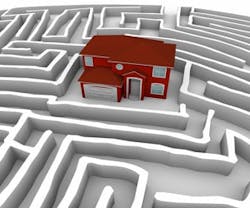Getting Lost in Architecture
Psychological scientists could help architects understand where and why people get lost inside buildings, according to an article published in Current Directions in Psychological Science, a journal of the Association for Psychological Science.
Cognitive mapping – a representation in your mind of the locations in the environment – plays a big role in maneuvering and navigating an architectural environment.
“If you paid attention to the sequence of turns along the path, then you may have difficulty because you need to remember to reverse the sequence, and this becomes increasingly difficult as the number of turns increases. But instead, if you paid more attention to the objects that you passed, then you may navigate back to the front door by going from one familiar object to another without considering the sequence of turns. This strategy will work, as long as you can always see a familiar object. If you get lost and enter an unexplored part of the building, you will have difficulty finding your way back,” says Laura A. Carlson of the University of Notre Dame, first author of the article.
Buildings that utilize obvious structure and long lines of sight won’t have people relying on cognitive mapping very much. But other buildings, like the Seattle Central Library (which won awards for its design), can be difficult to navigate. Varying layouts, walls that don’t line up, and challenging sight lines make cognitive mapping and subsequent movement difficult.
There’s a simple trick for boosting your cognitive mapping abilities in a new area. “I used to worry when I explore a new city by myself that I would not find my way back to the hotel,” Carlson says. “However, this simple trick is effective. At each intersection where I need to turn, I spin around to see what the intersection will look like from my return perspective. That way, I will be able to recognize it from the other direction, and I can store that view also in my cognitive map.”
Architectural innovations and easier-to-navigate buildings could result from cognitive mapping research.
